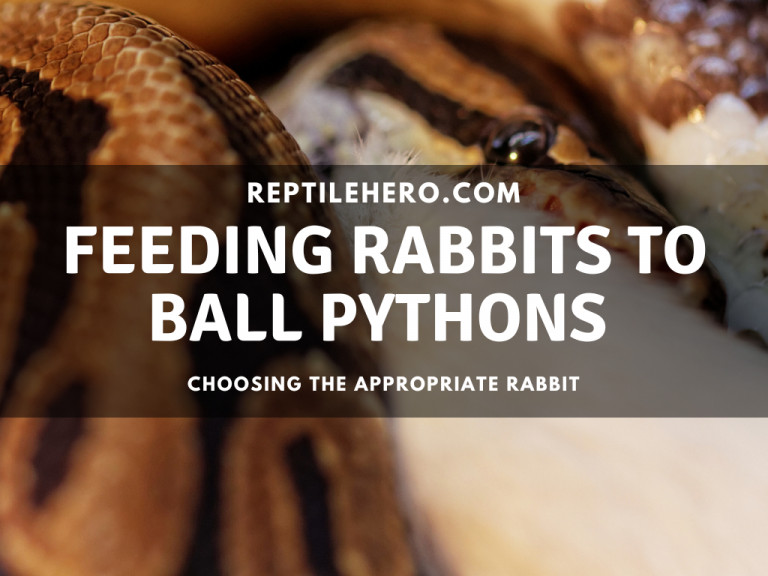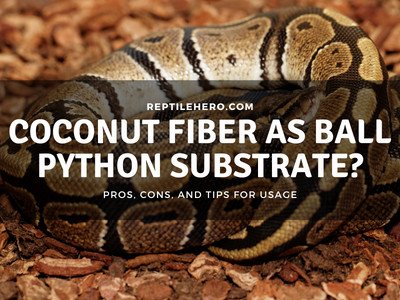Does Ball Python Poop Smell? (When Should You be Worried?)
As a newbie keeper, ball python poops may be one of your worries before getting a pet reptile—does it smell bad? Or, perhaps, you are a worried ball python owner when you see it poop weird stuff! What should its poop look like and when do you need to worry for the safety of your ball python?
The average ball python’s feces will smell bad like most animal droppings. However, if the smell is unusual and unbearable and it has a wet consistency then it can be a sign of a problem such as bad food, endoparasites, or improper husbandry.
Ball python poop is comparable to what a dog stool looks like. But can you determine a ball python’s health through its poop? What should you do if your snake has not yet defecated in months? Find out more about these as you read below!
A Healthy Ball Python’s Droppings (3 Factors to Check!)
Ball python droppings should smell like most other fecal matter and look like brown solids accompanied by chalky urates.
There are 3 factors to determine if it is a normal poop, namely: 1) smell, 2) coloration, and 3) consistency.
1. Smell
Ball pythons do not have a distinct smell, but their poop will naturally emit a bad odor like any other fecal matter. The smell of their feces can be noticeable when opening up an enclosure.
The smell of a ball python’s poop will be similar to what a dog’s feces smell like because they both have a protein-based diet.
Ball pythons in enclosed plastic bins or rack systems often have worse fecal odors than ball pythons situated in screen-type ones. This is due to the lack of ventilation inside an enclosure to dry out the snake poop.
2. Color
Ball python feces should be brown, similar to dog poop. Normally, it is also accompanied by their urine and urate. Their urine is usually clear or yellow in coloration. Urates will typically be white or yellow.
Ball pythons will sometimes release only urates and no poop and vice-versa. This is normal and this will vary depending on the type of feeder you gave them and the age of your snake.
3. Consistency
Ball pythons have solid feces and urates, while the pee is in liquid form. A healthy feces should be soft but solid while the urates have a chalk-like texture.
If your snake often has watery poops accompanied by strange movements, then I recommend bringing its stool to a veterinary doctor for fecal testing.
What Can Cause a Ball Python Poop to Smell Bad?
The main causes of bad-smelling ball python feces are: 1) endoparasites, 2) bad food, and 3) improper husbandry.
1. Endoparasites
Overall, endoparasites can cause digestional issues which lead to a foul-smelling stool in ball pythons. These parasites can also be transmitted through feeders, tools, and other reptiles.
Common examples of endoparasites are Coccidia, Strongylidas, and Ascaris [2][3].
Parasite-infested ball pythons may show symptoms like:
- Refusal to eat
- Diarrhea
- Stress
- Dehydration
- Malnourishment
If the symptoms mentioned above are exhibited by your ball python, I highly suggest bringing fecal samples to be checked by an exotic veterinary doctor.
Pro Tip: To prevent parasitic transmissions, always quarantine newly purchased ball pythons. When quarantining a snake, it should be in a separate room with a separate set of equipment. This should last for at least 3 months.
2. Bad Food
In general, feeders that are unhealthy can transmit parasites to a ball python. But the main cause of bad-smelling feces in ball pythons is rotten feeders. Additionally, excessively large feeders can make a python’s droppings smell foul.
Frozen thawed feeders can also rot if not stored properly. So I recommend ordering from a legitimate store that ships in good packaging to avoid receiving it in bad condition.
If you do not want to feed live feeders, I recommend having them pre-killed using carbon gas poisoning or dislocation which are quick and humane ways of killing feeders.
With these, you will not encounter a rotten one and will avoid wetting the feeder itself.
Feeder size is also important for ball pythons. A meal that is too large can cause constipation and the holdback of waste can accumulate and lead to a large quantity and bad-smelling fecal matter.
So remember to only give ball pythons feeders that are 10-15% of their total body weight.
3. Improper Husbandry
Improper ball python husbandry can also cause bad-smelling feces which is caused by incorrect factors like: temperature, humidity, and substrate.
Take note of the general husbandry parameters indicated in the table below:
| Husbandry | Recommendation |
| Temperature | 75-93°F (24-34°C) |
| Humidity | 50-70% (80% when shedding) |
| Substrate | Coco-substrates, cypress mulch, aspen beddings, bioactive substrate |
Low temperatures and humidity can lead to dehydration and constipation which can lead to a bad-smelling ball python poop.
These parameters can also cause stress to a ball python that also affects its bowel movement [4].
>>Learn more about substrates in our article on bioactive tank substrates.
How to Lessen Bad Smell of Ball Python Droppings?
Ball pythons do not smell bad but their waste will smell bad over time when left uncleaned. Some ways to lessen their bad smell are: 1) ventilation, 2) substrate change, and 3) clean water.
1. Ventilation
As a whole, ball python wastes will smell even worse when the enclosure is not well ventilated. High humidity with low circulation will prevent the stool from drying out, thus making the smell worse.
I recommend a well-ventilated enclosure if you can keep the humidity up. This will allow the fecal matter to dry out quickly and circulate the air to minimize the smell coming from ball python droppings.
2. Substrate Change
As a rule of thumb, an unchanged substrate will often cause a bad smell in a ball python’s enclosure. Wastes left by a ball python should be spot cleaned immediately.
Ball pythons typically urinate at the same time as they release their feces and urates. So I would recommend changing the substrate around the stool when spot cleaning your enclosure.
For most substrates, I recommend changing it once or twice a month to prevent bacteria build-up that may harm the snake.
If you are having a problem with your ball python’s smelly waste, I recommend using an absorbent substrate like Aspen shavings. Just a reminder that it will lessen the smell but it can also greatly lower the humidity inside your python’s enclosure.
Want to try using aspen bedding? I personally recommend this product from Amazon. I have used them for 5 years and had success with them. They are dust free and absorbent, perfect for keepers situated in a humid location!
3. Clean Water
Ball pythons commonly also release their waste in their water dishes, so it is highly recommended to provide clean fresh water at least once a week or replace it once it is soiled.
A spilled water dish can also wet the defecations of ball pythons which can cause mold and bacteria to grow rapidly resulting in even more foul smells.
2 Signs of Illness in Ball Python Poop
A ball python poop is not good if it has 1) watery consistency and 2) blood. These signs are indicative of diseases or parasitic infestations.

1. Wet Consistency
If a ball python constantly has runny or wet droppings then it might be caused by internal parasites. However, if it only happens once or rarely, then it may only be due to bad food.
Parasites can come from sick feeders or through other snakes. These kinds of infestations are often accompanied by foul-smelling, wet stools.
Another cause of ball python diarrhea is stress. Stress can be from improper husbandry and malnutrition.
If your ball python still has diarrhea consecutive times then I suggest taking a fecal sample to a veterinarian to check whether there is a parasitic infestation.
When a ball python has shown signs of diarrhea for the very first time, I recommend checking the food source to whether it is in the appropriate condition.
2. Bloody Discharge
Commonly, if a ball python’s feces have a few drops of blood in it, it is caused by the rubbing of their vents. But if there is a substantial amount of blood, then a python may be suffering from a more serious condition.
If the ball python’s poop has large pools of blood in it, then it is likely caused by endoparasites or internal wounds.
However, bloody discharge is not always a major cause of concern.
At times, ball pythons simply have wounded or scratched cloaca due to a large or improperly digested meal.
This is why I recommend gradually increasing the size of feeders to avoid sudden tensions in their digestive tracks.
My Ball Python Won’t Poop! (The 4 Common Causes)
Ball python constipation is commonly caused by: 1) dehydration, 2) low temperatures, 3) overfeeding, and 4) impactions
In general, ball pythons defecate at least once a month. If there is still no waste released after one month then the snake might be constipated.

1. Dehydration
Ball python dehydration is often caused by a lack of clean water and moisture inside an enclosure.
Some signs to look out for in a dehydrated snake are stuck shed, wrinkly body, refusal to eat, and more.
>> Learn more about dehydration and how to solve it in our article about ball python dehydration and wrinkles
2. Low Temperatures
A low temperature can also cause a ball python to improperly digest its food which can lead to a stool build-up around the tail area of the snake.
The lack of heat can also cause stress to a ball python which is another factor for defecation problems.
3. Overfeeding
Overfeeding can also cause constipation especially if the ball python is fed a huge amount of feeders even if there are no wastes released.
The fecal matter may build up inside their rectum and will be hard to release.
4. Impaction
Impaction is a rare risk for ball pythons which is caused by swallowing substrates like soil, coco husk, etc.
One sign to know whether or not your snake is impacted is by observing the area around its cloaca. If it looks big and feels hard, then an impaction might be the cause.
>> Learn more about proper feeding in our article on feeding mice and rats to a ball python.
Fun Fact: Most baby ball pythons will not poop for a long time and this is due to their body maximizing all of their food to convert as muscle mass and energy.
This is why most keepers of young ball pythons typically share that their babies only release urates at the beginning—and that is perfectly normal.
How do You Prevent Constipation in Ball Pythons? (3 Ways!)
Ball python constipation can be solved by: 1) clean water, 2) proper husbandry, and 3) a warm bath.
1. Regularly Provide Clean Water
Clean water should always be provided to a ball python. Stagnant, contaminated water can be detected by a ball python thus the reason why it can refuse to drink.
I recommend replacing its water bowl once a week or when it is soiled.
2. Ensure Proper Husbandry
Proper husbandry factors to take note of are: temperature, humidity, substrate, and feeder size. This will provide the ball python with the proper environment that also reduces their stress.
3. Give Lukewarm Baths
Lukewarm baths are the first aid solution when the solutions mentioned above did not work. I recommend a water temperature of 80-85°F and a soaking duration of 15 minutes. This method should be done as a last resort to avoid further stress for the snake.
If the warm bath did not work, I highly recommend going to a veterinarian for consultation.
Further Questions
How to get rid of a ball python poop smell?
When cleaning enclosures that are not that heavy, they should be washed and cleaned thoroughly with liquid soap. If the enclosure is heavy It is recommended to use a veterinary-approved disinfectant spray like F10 or diluted chlorhexidine and give it a good wipe after spraying.
How often does a ball python poop?
Ball pythons release stool from 5 days up to 2 months after feeding. The duration will vary based on different parameters like temperature, humidity, prey size, and overall husbandry. Pythons that have not defecated for more than 2 months might have an illness or parasitic infestation.
What are the organs that ball pythons use to store and release fecal matter?
The rectum temporarily stores fecal matter while the cloaca is the opening in which the wastes are released. These organs are located near the tail at the base of the snake’s body.
Summary of Does a Ball Python Poop Smell?
Like most fecal matter, ball python poop smells bad but is manageable. A foul smell coming from the droppings of a ball python might be a bad sign that there is something wrong.
If a ball python’s feces smell bad, it might be caused by endoparasites, bad food, and improper husbandry. The foul smell can be lessened through increased ventilation, changing the substrate, and giving clean water regularly.
Ball pythons typically release solid brown feces, chalk-like white/ yellow urates, and clear/yellow urine. An unhealthy ball python defecation can have wet consistency and can also have bloody discharge.
Resources
[3] https://actavetscand.biomedcentral.com/track/pdf/10.1186/1751-0147-53-33.pdf







